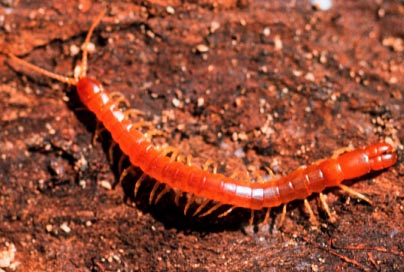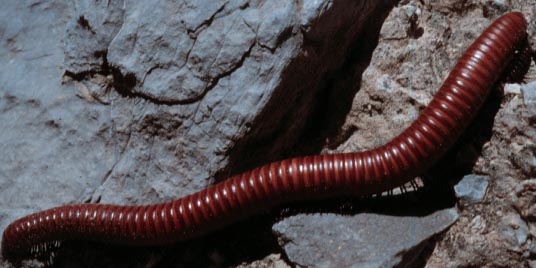
A centipede, Scolopendra sp. (Chilopoda Scolopendromorpha: Scolopendridae).
Photo by Drees.
Common Name: Centipede, millipede
Scientific Name: Varies
Order: Chilopoda and Diplopoda
Description: Centipedes can easily be distinguished from millipedes by counting the number of pairs of legs arising from most body segments: millipedes have two pairs, while centipedes bear one pair per segment, with the first pair of legs being modified into fangs. Centipedes are generally flattened and have a pair of well developed antennae on the head. Some centipedes, such as the house centipede (Scutigera coleoptrata Linnaeus), have long legs and are capable of running rapidly. The largest centipedes, Scolopendra spp. (Scolopendromorpha: Scolopendridae) may grow to be about 6 inches long. Millipede bodies are rounded or somewhat flattened. Legs are short and movement is slow, with movement of legs appearing wave-like. Most species are less than 1 ½ inch long, although one species, Narceus americanus (Beauvois) (Order Spirobolida), in west Texas grows up to 4 inches long.

A millipede, (Diplopoda).
Photo by Jackman.
Life Cycle: Simple metamorphosis. Centipedes and millipedes spend the winter as adults in protected habitats and become active in the spring. During the warmer months, females lay eggs in soil and cover them with a sticky substance, although some species give birth to living young. Immature stages (larvae) hatching from eggs several days later are similar to adults but smaller, having fewer leg-bearing body segments. Additional leg-bearing segments are produced with each molt. Millipedes develop through about seven stages (instars) in 21 to 25 weeks. Some centipedes are known to have lived up to 6 years.
Habitat, Food Source(s), Damage: Mouthparts are for chewing. Centipedes and millipedes prefer to live in moist habitats and during the day occur underneath rocks, logs and other objects in contact with the ground. They are active at night. Centipedes feed on insects and spiders. They kill by grasping prey with their powerful fangs and injecting venom. The fangs are located on the body segment just behind the head. Millipedes feed on decomposing organic matter, but will occasionally damage seedling plants by feeding on leaves, stems and roots. They curl up tightly when disturbed resulting frequently in the release of fluids from repugnatorial glands.
Pest Status: Mainly be nuisance pests; have poison glands connected to a pair of jaws and will bite if provoked. The bite is usually not medically threatening except to small children and individuals allergic to venoms. The larger species have more painful bites. Millipedes do

A millipede, (Diplopoda). Photo by Drees.
not bite; but when disturbed they can produce an irritating fluid (using repugnatorial glands opening at the base of the legs). This fluid can irritate eyes, blister the skin, produce an unpleasant odor and cause allergic reactions in venom sensitive people. Some species can squirt their fluids several inches. Millipedes, such as the garden millipede (Oxidus gracilis, Polydesmida: Paradoxosomatidae), can become numerous in the greenhouse and damage crops. They may invade homes during cooler weather.
For additional information, contact your local Texas A&M AgriLife Extension Service agent or search for other state Extension offices.
Literature: Brook et al. 1982; Drees & Wicksten 1990.